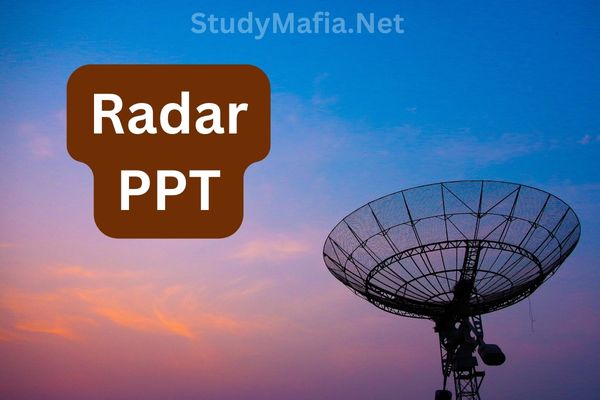Radar PPT Presentation Seminar with pdf report: Radio detection and ranging is nothing but the radar, in the past few decades, the radar has become very famous in several major fields like research, aircraft, and commerce. Initially, the radar was developed for the military purposes and later it was used in wide range of applications.
More Seminar Topics
The British and United States military use the radar for locating the ships and airplanes and to know about them. Now radar is a vital tool to predict the weather and to analysis the weather. Along with all these benefits, there are some disadvantages of radar too like the timings of radar because it takes two seconds to lock it.

Radar Seminar and PPT with PDF Report
Functions of Radar:
The normal functions of a radar is to detect the range of target from the pulse delay, velocity from Doppler frequency shift and angular direction of the target from the direction of antenna pointing, target size from the return signal’s magnitude, target shape and components can be known from the direction and at last the material composition.
The price i.e. cost and size of the radar enhances as the functions of the radar enhances.
Also see: Geothermal Energy PPT Presentation Seminar
Types of Radar:
Let us see the classification of radar based on specific function is of two types, they are as follows:
- Primary Radar
- Secondary Radar
The primary radars are classified into two types and they are:
- Continuous wave radar
- Pulse wave radar
The continuous wave radars are classified into two types and they are as follows:
- Modulated continuous wave radar
- Unmodulated continuous wave radar
The pulse wave radars are classified are classified into two types and they are as follows:
- Moving target radar
- Pulse Doppler radar
Primary radar: The primary radar sends high-frequency signals towards the targets and the pulses that were sent by the radar are reflected by the target. The same primary radar receives the signals and those reflected signals are called as echoes, echoes undergoes further operations to get the information or data about the target.
Secondary radar: The secondary target uses an extra component than the primary radar called transponder on the target. The radar at the ground level which is called as interrogator transmits or sends the signals to the target. The transponder of the target receives the signal and decodes the signal and after that, it sends the signals to the interrogator unit and this unit demodulate the received signal. Through this, we get various kind of information like the identity of the airplane, position of the airplane and much more.
Now, coming on the further classifications we need to describe the following radars:
Also See: GSM PPT Presentation Seminar Free Download
Continuous wave radar: This type of radar continuously sends the signals towards the target and reflected signals are also received and further operations are done continuously.
- Unmodulated continuous wave radar: This type of radar transmits the signals of continuous amplitude and frequency that are used to detect an only speed of the target by availing the Doppler Effect but cannot measure the range of the target.
- Modulated continuous wave radar: The unmodulated continuous wave radars have the disadvantage of not detecting the range of a target and this can be measured in modulated continuous wave radar by using the frequency shift method.
Pulse wave radar: This type of radars transmits the high-frequency pulses and high power pulses towards the target. It waits for the received signal before transmitting a new pulse wave.
- MTI (Moving target radar): This type of radar uses low pulse repetition frequency to shun range uncertainties but these radars can possess Doppler uncertainties.
- Pulse Doppler radar: It uses high pulse repetition frequency to avoid Doppler uncertainties but it can possess many range uncertainties.
Advantages of radar:
- Radar furnishes high penetration capability through any type of weather condition and it works in the day and night.
- Radar can be availed in a number of waves.
- Radar possesses the stationary mode, moving mode, and two direction modes.
- The beam spreader by the radar can incorporate many targets.
Disadvantages of radar:
- Radar has the disadvantage of time and that is it can take two seconds to get the lock.
- The large targets that are close to radar can saturate the receiver.
- The hand-held modulation can falsify readings.
- It has many interference sources.
Hence, this about the radar and there are many developments that we can make in radar. Overall it is a good option to use in the military because it is very flexible.
Content of the Seminar and pdf report for Radar PPT Presentation
- Introduction
- History
- What is Radar?
- Function of Radar
- Types
- Application
- Principle
- Advantages
- Disadvantages
- Conclusion
Here we are giving you Radar Seminar and PPT with PDF report. All you need to do is just click on the download link and get it.
Radar PPT and Seminar Free Download
Radar pdf Report Free Download
It was all about Radar PPT Presentation Seminar with pdf report. If you liked it then please share it or if you want to ask anything then please hit comment button.